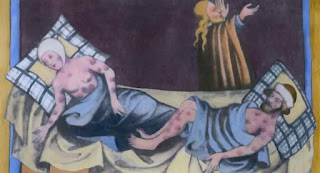"The Grim Reaper's Arsenal: Exploring the Deadliest Diseases in Human History"
Throughout history, there have been several deadly diseases that have ravaged populations, causing widespread illness and death. These diseases have been responsible for millions of deaths and have left an indelible mark on human history. In this article, we will discuss some of the deadliest diseases in history.
The Black Death:
It first emerged in China in the 1330s and spread rapidly throughout Europe, killing an estimated 75-200 million people.
The disease was caused by the bacterium Yersinia pestis, which was transmitted by fleas that infested rats. The Black Death caused fever, chills, and swollen lymph nodes, and it could lead to death within days of infection.
Smallpox:
 The Spanish Flu, also known as the 1918 flu pandemic, was one of the deadliest pandemics in history.
The Spanish Flu, also known as the 1918 flu pandemic, was one of the deadliest pandemics in history.
 HIV/AIDS is a viral disease that attacks the immune system. It was first identified in the 1980s and has since spread rapidly throughout the world.
HIV/AIDS is a viral disease that attacks the immune system. It was first identified in the 1980s and has since spread rapidly throughout the world.
The disease was caused by the variola virus and was highly contagious.
Smallpox caused fever, headaches, and a severe rash that covered the body.
The disease was responsible for the deaths of an estimated 300-500 million people during the 20th century alone.
Spanish Flu:
 The Spanish Flu, also known as the 1918 flu pandemic, was one of the deadliest pandemics in history.
The Spanish Flu, also known as the 1918 flu pandemic, was one of the deadliest pandemics in history. It infected an estimated 500 million people and caused the deaths of between 50 and 100 million people worldwide.
The flu was caused by the H1N1 virus, and it spread quickly due to the close quarters of soldiers during World War I.
HIV/AIDS:
 HIV/AIDS is a viral disease that attacks the immune system. It was first identified in the 1980s and has since spread rapidly throughout the world.
HIV/AIDS is a viral disease that attacks the immune system. It was first identified in the 1980s and has since spread rapidly throughout the world. The disease is spread through unprotected sexual contact, sharing needles, or from mother to child during pregnancy or childbirth. HIV/AIDS has killed an estimated 32 million people worldwide, and there is currently no cure for the disease.
Tuberculosis:
Tuberculosis:
Tuberculosis (TB) is a bacterial disease that affects the lungs. It is spread through the air when an infected person coughs or sneezes.
TB is one of the oldest diseases in human history and has affected millions of people throughout the centuries. The disease causes fever, coughing, and chest pain and can be fatal if left untreated.
Malaria:
Malaria is a parasitic disease that is transmitted by mosquitoes. The disease causes fever, chills, and flu-like symptoms and can be fatal if left untreated.
Malaria has been responsible for the deaths of millions of people throughout history, particularly in sub-Saharan Africa.
Cholera:
Cholera:
Cholera is a bacterial disease that is spread through contaminated water or food. The disease causes severe diarrhea and dehydration and can be fatal if left untreated.
Cholera has been responsible for several deadly outbreaks throughout history, particularly in densely populated areas with poor sanitation.
In conclusion, these are just some of the deadliest diseases in history. While medical advancements have made it possible to treat and prevent many of these diseases, they continue to pose a threat to global health. It is important to remain vigilant and take steps to prevent the spread of these diseases to avoid future pandemics.
In conclusion, these are just some of the deadliest diseases in history. While medical advancements have made it possible to treat and prevent many of these diseases, they continue to pose a threat to global health. It is important to remain vigilant and take steps to prevent the spread of these diseases to avoid future pandemics.
#disease, #diseasefreelife, #diseasemanagement, #diseasefreebody, #diseasex, #diseasemedia, #diseasesofbone, #diseasereversal, #disease_control, #diseasefree, #diseases_coverage, #diseasereversediet, #diseasebykhansir, #diseasesofoldage











